Optimizing Row Spacing Increases Stalk Lodging Resistance by Improving Light Distribution in Dense Maize Populations
Abstract
:1. Introduction
2. Materials and Methods
2.1. Experimental Site
2.2. Experimental Design
2.3. Sampling and Measurements
2.3.1. Light Distribution
2.3.2. Internode Morphology and Dry Matter Accumulation
2.3.3. Internode Anatomic Structure
2.3.4. Internode Mechanical Strength
2.3.5. Internode Structure Material Content
2.3.6. Field Lodging and Folding Rates
2.3.7. Grain Yield
2.4. Statistics Analysis
3. Results
3.1. Light Transmittance and Extinction Coefficient
3.2. Morphology and Material Enrichment of Basal Internodes
3.3. Vascular Bundles and Mechanical Organization of Basal Internodes
3.4. Cellulose and Lignin Contents of Basal Internodes
3.5. Crushing and Breaking Strength of Basal Internodes
3.6. Stalk Lodging and Folding Rates and Grain Yield
3.7. Relationship between Lodging Rate and Basal Internode Characteristics of Maize
3.8. Relationships between Basal Internode Characteristics, Lodging Resistance, and Light Transmittance in Maize Populations
4. Discussion
4.1. Light Transmittance Is an Important Ecological Factor Influencing Basal Internode Characteristics and Lodging Resistance of Maize
4.2. Planting Density and Row Spacing Influence Stalk Lodging Resistance by Regulating the Light Distribution in Maize Populations
4.3. Optimizing Row Spacing Is an Important Strategy for Lodging Resistance and High Yield in Dense Maize Plantations
5. Conclusions
Supplementary Materials
Author Contributions
Funding
Data Availability Statement
Conflicts of Interest
References
- Cheng, Y.; Zhao, J.; Liu, Z.; Huo, Z.; Liu, P.; Dong, S.; Zhang, J.; Zhao, B. Modified fertilization management of summer maize (Zea mays L.) in northern China improves grain yield and efficiency of nitrogen use. J. Integr. Agric. 2015, 14, 1644–1657. [Google Scholar] [CrossRef]
- Li, Q.; Wu, Y.W.; Chen, W.; Jin, R.; Kong, F.L.; Ke, Y.P.; Shi, H.C.; Yuan, J.C. Cultivar differences in root nitrogen uptake ability of maize hybrids. Front. Plant Sci. 2017, 8, 1060. [Google Scholar] [CrossRef] [PubMed]
- Jia, Q.; Xu, Y.; Ali, S.; Sun, L.; Ding, R.; Ren, X.; Zhang, P.; Jia, Z. Strategies of supplemental irrigation and modified planting densities to improve the root growth and lodging resistance of maize (Zea mays L.) under the ridge-furrow rainfall harvesting system. Field Crops Res. 2018, 224, 48–59. [Google Scholar] [CrossRef]
- Tokatlidis, I.S.; Koutroubas, S.D. A review of maize hybrids’ dependence on high plant populations and its implications for crop yield stability. Field Crops Res. 2004, 88, 103–114. [Google Scholar] [CrossRef]
- Wang, K.R.; Xie, R.Z.; Ming, B.; Hou, P.; Xue, J.; Li, S.K. Review of combine harvester losses for maize and influencing factors. Int. J. Agric. Biol. Eng. 2021, 14, 1–10. [Google Scholar] [CrossRef]
- Baker, C.J.; Berry, P.M.; Spink, J.H.; Bradley, R.S.; Griffin, J.M.; Scott, R.K.; Clare, R.W. A method for the assessment of the risk of wheat lodging. J. Theor. Biol. 1998, 194, 587–603. [Google Scholar] [CrossRef]
- Baker, C.J.; Sterling, M.; Berry, P. A generalised model of crop lodging. J. Theor. Biol. 2014, 363, 1–12. [Google Scholar] [CrossRef]
- Zhan, X.X.; Kong, F.L.; Liu, Q.L.; Lan, T.Q.; Liu, Y.Q.; Xu, J.Z.; Ou, Q.; Chen, L.; Kesse, G.; Kemoenaar, C.; et al. Maize basal internode development significantly affects stalk lodging resistance. Field Crops Res. 2022, 286, 108611. [Google Scholar] [CrossRef]
- Wang, C.; Ruan, R.W.; Yuan, X.H.; Hu, D.; Yang, H.; Li, Y.; Yi, Z.L. Effects of nitrogen fertilizer and planting density onthe lignin synthesis in the culm in relation to lodging resistance of buckwheat. Plant Prod. Sci. 2015, 18, 218–227. [Google Scholar] [CrossRef]
- Wang, Q.; Xue, J.; Chen, J.L.; Fan, Y.H.; Zhang, G.Q.; Xie, R.Z.; Ming, B.; Hou, P.; Wang, K.R.; LI, S.K. Key indicators affecting maize stalk lodging resistance of different growth periods under different sowing dates. J. Integr. Agric. 2020, 19, 2419–2428. [Google Scholar] [CrossRef]
- Zheng, Y.X.; Chen, D.; Wei, P.C.; Lu, P.; Yang, J.Y.; Luo, S.K.; Ye, K.M.; Song, B. Effects of planting density on lodging resistance and grain yield of spring maizestalks in Guizhou province. Acta Agron. Sin. 2021, 47, 738–751. [Google Scholar] [CrossRef]
- Xue, J.; Gou, L.; Shi, Z.G.; Zhao, Y.S.; Zhang, W.F. Effect of leaf removal on photosynthetically active radiation distribution in maize canopy and stalk strength. J. Integr. Agric. 2017, 16, 85–96. [Google Scholar] [CrossRef]
- Liu, X.L.; Ma, X.J.; Dou, P.; Huang, K.C.; Wang, X.L.; Zhang, D.; Kong, F.L.; Yuan, J.C. Effect of planting density on stem characteristics and yield of summer maize in the Hilly Central Sichuan Basin, China. Chin. J. Eco-Agric. 2017, 25, 356–364. [Google Scholar]
- Ren, H.; Jiang, Y.; Zhao, M.; Qi, H.; Li, C.F. Nitrogen supply regulates vascular bundle structure and matter transport characteristics of spring maize under high plant density. Front. Plant Sci. 2021, 11, 602739. [Google Scholar] [CrossRef]
- Xue, J.; Gou, L.; Zhao, Y.S.; Yao, M.N.; Yao, H.S.; Tian, J.S.; Zhang, W.F. Effects of light intensity within the canopy on maize lodging. Field Crops Res. 2016, 188, 133–141. [Google Scholar] [CrossRef]
- Yang, Y.S.; Guo, X.X.; Hou, P.; Xue, J.; Liu, G.Z.; Liu, W.M.; Wang, Y.H.; Zhao, R.L.; Ming, B.; Xie, R.Z.; et al. Quantitative effects of solar radiation on maize lodging resistance mechanical properties. Field Crops Res. 2020, 255, 107906. [Google Scholar] [CrossRef]
- Mohammadi, G.R.; Ghobadi, M.E.; Sheikheh-Poor, S. Phosphate biofertilizer, row spacing and plant density effects on maize (Zea mays L.) yield and weed growth. Am. J. Plant Sci. 2012, 3, 425–429. [Google Scholar] [CrossRef]
- Maddonni, G.A.; Otegui, M.E.; Cirilo, A.G. Plant population density, row spacing and hybrid effects on maize cannoy architecture and light attention. Field Crops Res. 2001, 71, 183–193. [Google Scholar] [CrossRef]
- Qi, B.Q.; Ma, B.Y.; Xue, J.; Li, B.X.; Hu, J.; Zhang, W.F.; Gou, L. Lodging resistance increased by varying the distance between adjacent maize rows. Agron. J. 2021, 113, 3315–3325. [Google Scholar] [CrossRef]
- Chen, S.H.; Chen, H.L.; Shen, X.S.; Liu, D.H. Effects of planting density and nitrogen amount on stalk lodging-resistance and yield of summer maize in Sichuan basin. Agric. Sci. Technol. 2012, 13, 2147–2151. [Google Scholar]
- Shi, D.Y.; Li, Y.H.; Zhang, J.W.; Liu, P.; Zhao, B.; Dong, S.T. Effects of plant density and nitrogen rate on lodging-related stalk traits of summer maize. Plant Soil Environ. 2016, 62, 299–306. [Google Scholar] [CrossRef]
- Yang, J.S.; Geng, W.J.; Zhang, J.W.; Ren, B.Z.; Wang, L.C. Responses of the lodging resistance of summer maize with different gene types to plant density. Agronomy 2022, 12, 10. [Google Scholar] [CrossRef]
- Xue, J.; Qi, B.Q.; Ma, B.Y.; Li, B.X.; Gou, L. Effect of altered leaf angle on maize stalk lodging resistance. Crops Sci. 2021, 61, 689–703. [Google Scholar] [CrossRef]
- Li, G.H.; Zhong, X.H.; Tian, K.; Huang, N.R.; Pan, J.F.; He, T.H. Effect of nitrogen application on stem lodging resistance of rice and its morphological and mechanical mechanisms. Sci. Agric. Sin. 2013, 46, 1323–1334. [Google Scholar]
- Gao, J.F. Plant Physiology Experiment Guidance; Higher Education Press: Beijing, China, 2006; pp. 105–107. [Google Scholar]
- Jiang, T.D. Lignin, 2nd ed.; Chemical Industry Press: Beijing, China, 2009; pp. 88–103. [Google Scholar]
- Ma, Q.Q.; Wang, X.H.; Sun, J.B.; Mao, T.L. Coordinated regulation of hypocotyl cell elongation by light and ethylene through a microtubule destabilizing protein. Plant Physiol. 2018, 176, 678–690. [Google Scholar] [CrossRef]
- Zhong, X.H.; Liang, K.M.; Peng, B.L.; Tian, K.; Li, X.J.; Huang, N.R.; Liu, Y.Z.; Pan, J.F. Basal internode elongation of rice as affected by light intensity and leaf area. Crops J. 2020, 8, 62–70. [Google Scholar] [CrossRef]
- Xu, Y.; Wang, C.; Zhang, R.; Ma, C.M.; Dong, S.K.; Gong, Z.P. The relationship between internode elongation of soybean stems and spectral distribution of light in the canopy under different plant densities. Plant Prod. Sci. 2021, 24, 326–338. [Google Scholar] [CrossRef]
- Su, G.X.; An, Z.F.; Zhang, W.H.; Liu, Y.L. Light promotes the synthesis of lignin through the production of H2O2 mediated by diamine oxidases in soybean hypocotyls. J. Plant Physiol. 2005, 162, 1297–1303. [Google Scholar] [CrossRef]
- Chang, J.F.; Zhang, H.H.; Li, H.P.; Dong, P.F.; Li, C.H. Effects of different row spaces on canopy structure and resistance of summer maize. Acta Agron. Sin. 2016, 42, 104–112. [Google Scholar] [CrossRef]
- Yang, J.S.; Gao, H.Y.; Liu, P.; Li, G.; Dong, S.T.; Zhang, J.W.; Wang, J.F. Effects of planting density and row spacing on canopy apparent photosynthesis of high-yield summer maize. Acta Agron. Sin. 2010, 36, 1226–1233. [Google Scholar] [CrossRef]
- Xue, J.; Zhao, Y.S.; Gou, L.; Shi, Z.G.; Yao, M.N.; Zhang, W.F. How High Plant Density of Maize Affects Basal Internode Development and Strength Formation. Crops Sci. 2016, 56, 3295–3306. [Google Scholar] [CrossRef]
- Bernhard, B.J.; Below, F.E. Plant population and row spacing effects on maize: Plant growth, phenology, and grain yield. Agron. J. 2020, 112, 2456–2465. [Google Scholar] [CrossRef]
- Gao, Y.B.; Tao, H.B.; Huang, S.B.; Tian, B.J.; Wang, L.J.; Yun, L.; Ren, J.H.; Pu, W. Effects of high planting density and row spacing on canopy light distribution and photosynthetic characteristics of summer maize. J. China Agric. Univ. 2015, 20, 9–15. [Google Scholar]
- Cui, H.Y.; Jin, L.B.; Li, B.; Zhang, J.W.; Zhao, B.; Dong, S.T.; Liu, P. Effects of shading on stalks morphology, structure and lodging of summer maizein field. Sci. Agric. Sin. 2012, 45, 3497–3505. [Google Scholar]
- Appenzeller, L.; Doblin, M.; Barreiro, R.; Wang, H.Y.; Niu, X.M.; Kollipara, K.; Carrigan, L.; Tomes, D.; Chapman, M.; Dhugga, K.S. Cellulose synthesis in maize: Isolation and expression analysis of the cellulose synthase (CesA) gene family. Cellulose 2004, 11, 287–299. [Google Scholar] [CrossRef]
- Yan, Q.J.; Huo, S.P.; Zhang, F.K.; Zhang, X.D.; Zhang, J.; Xiang, Z.F.; Yu, Z.J.; Feng, Y.C. Effects of artificial shaded-humid environment on growth characteristics in different maize inbred lines. Acta Agron. Sin. 2013, 39, 2253–2261. [Google Scholar] [CrossRef]
- Shao, L.P.; Li, G.; Zhao, Q.N.; Li, Y.B.; Sun, Y.T.; Wang, W.N.; Cai, C.; Chen, W.P.; Liu, R.H.; Luo, W.H.; et al. The fertilization effect of global dimming on crop yields is not attributed to an improved light interception. Global Change Biol. 2020, 26, 1697–1713. [Google Scholar] [CrossRef]
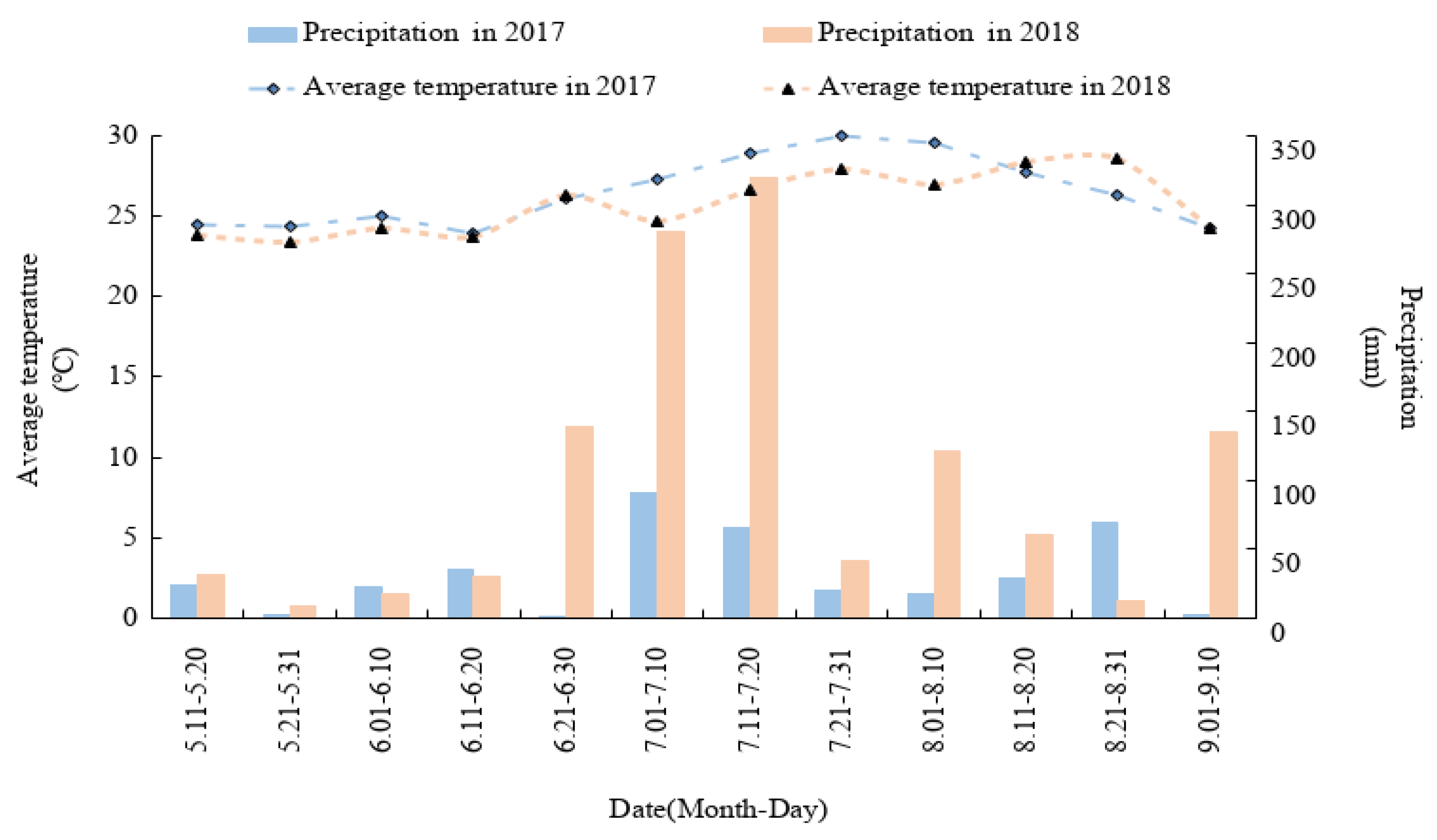
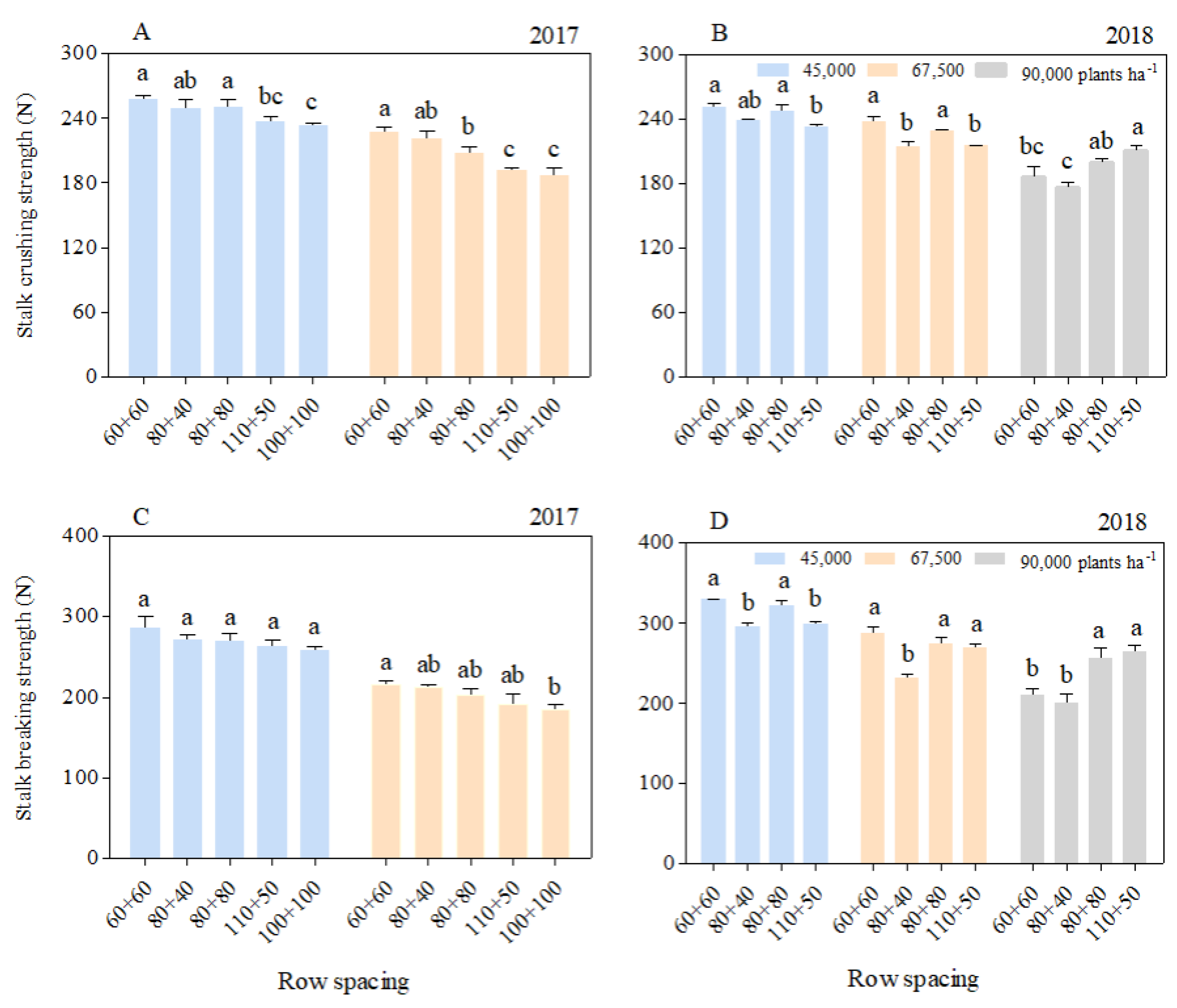
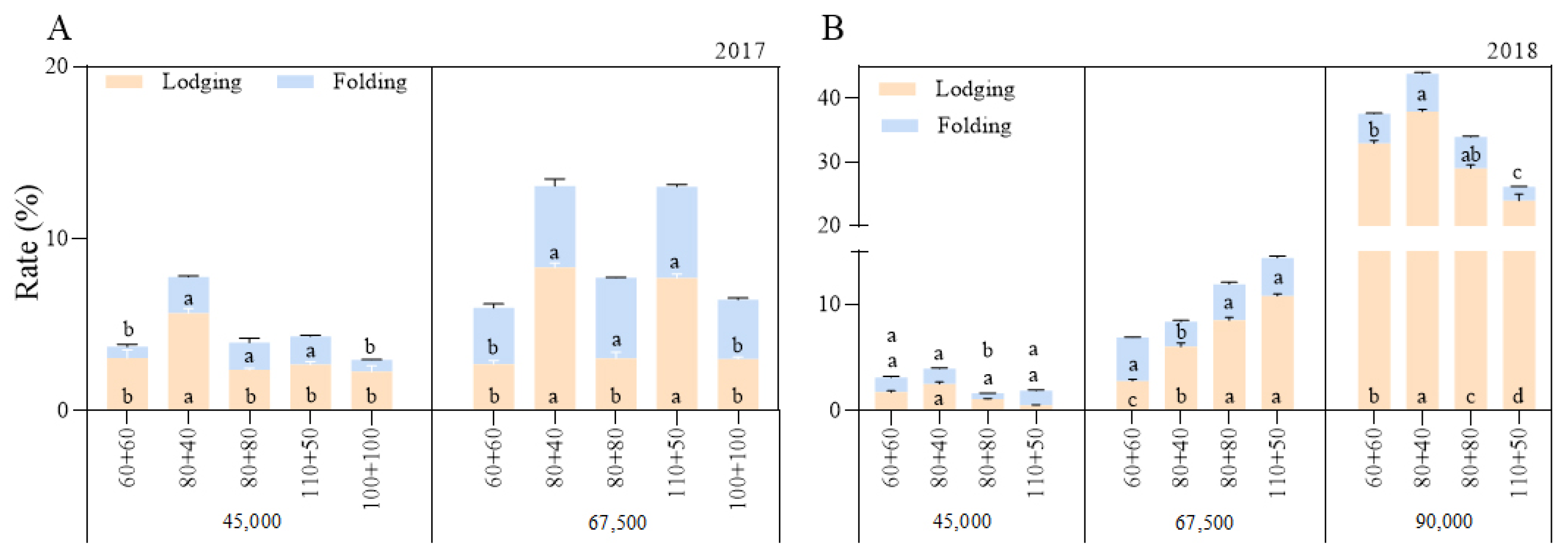
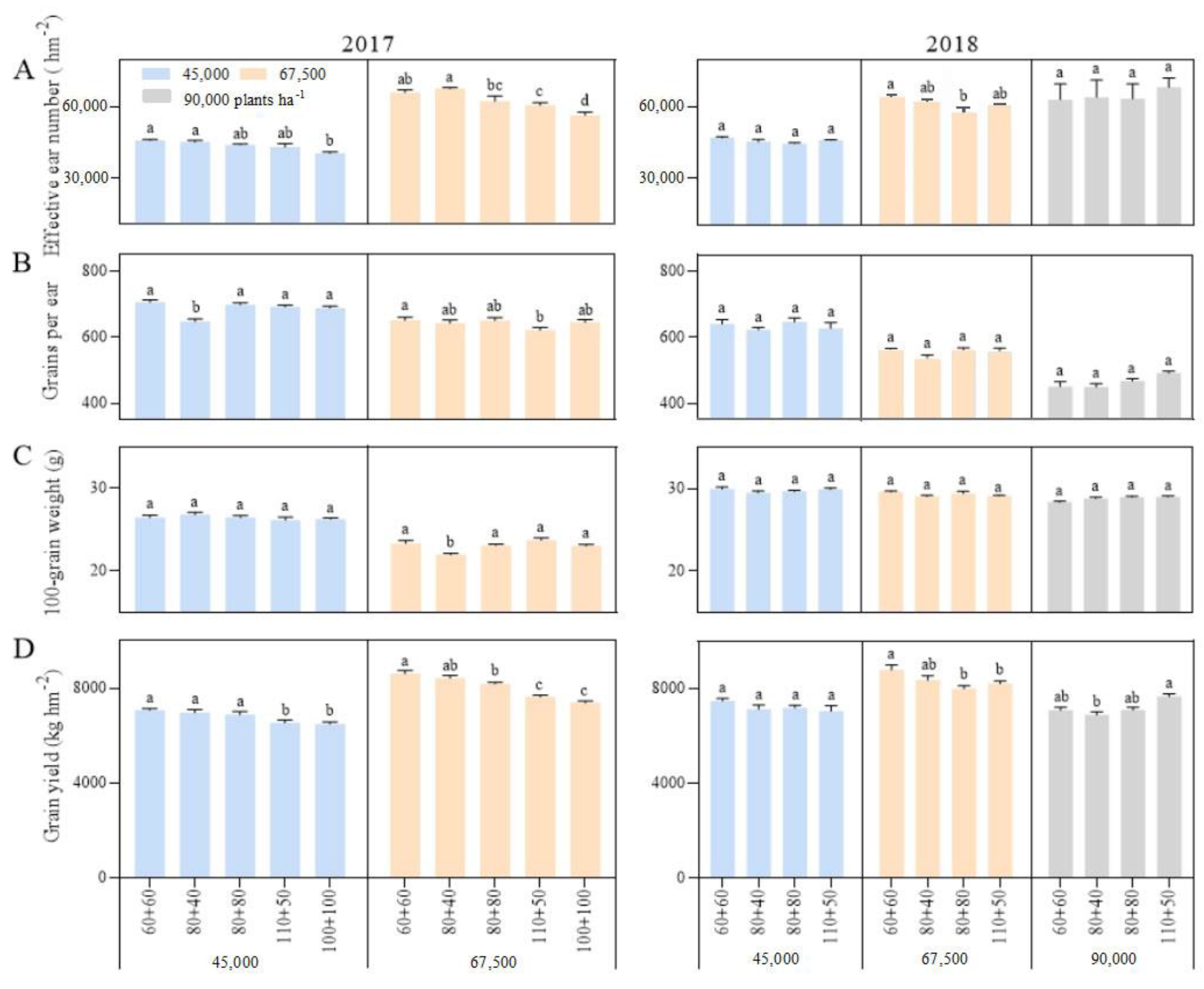
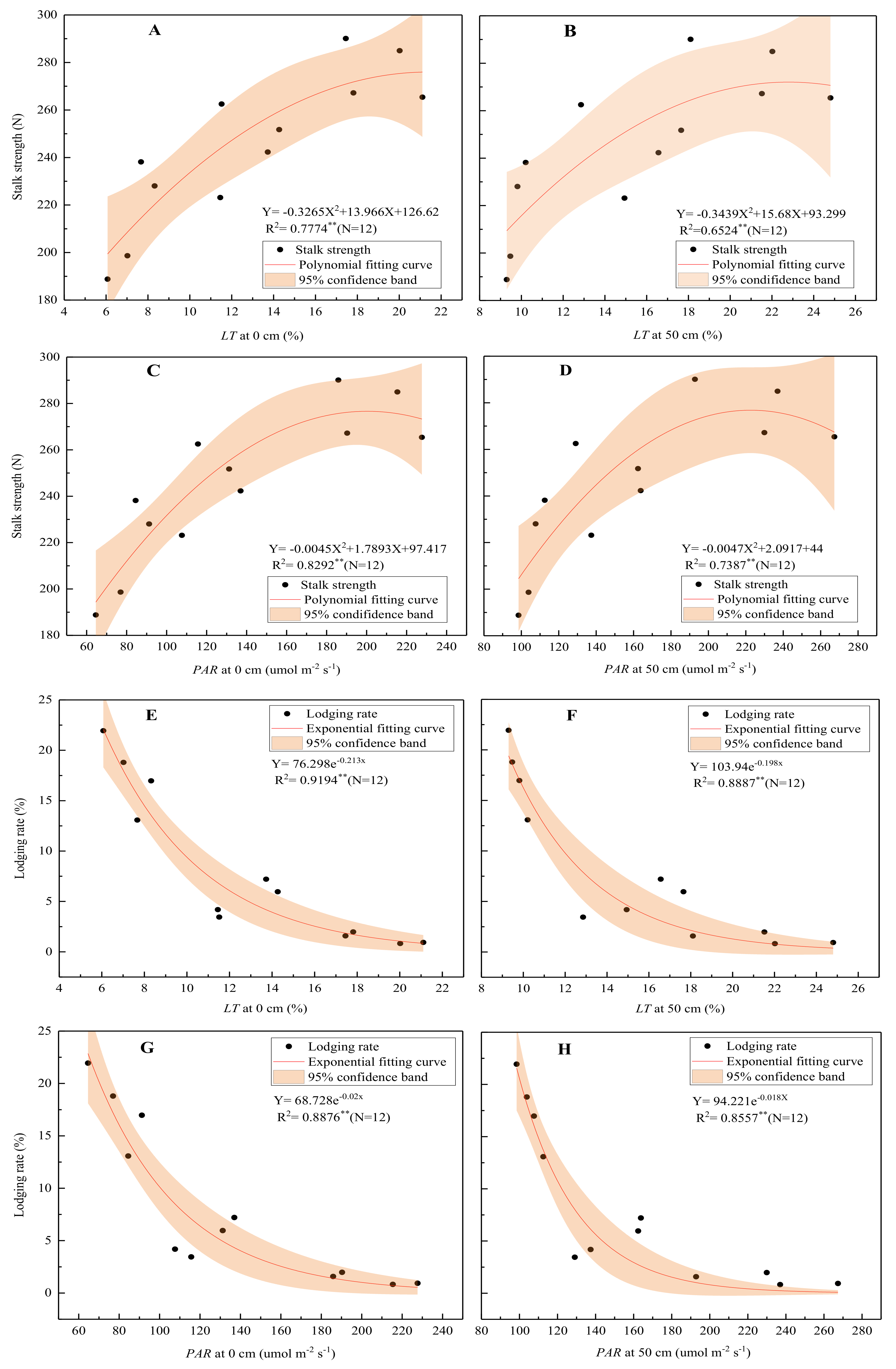
| Density (D) | Row Spacing (cm) | LT (%) | PAR (μmol m⁻2 s⁻1) | K | ||
|---|---|---|---|---|---|---|
| 0 cm | 50 cm | 0 cm | 50 cm | |||
| 45,000 | 60 + 60 | 17.45 | 18.10 | 185.90 | 192.83 | 0.0077 |
| 80 + 40-narrow | 11.95 | 13.61 | 125.83 | 143.28 | 0.0088 | |
| 80 + 40-wide | 23.68 | 29.43 | 254.83 | 316.65 | 0.0061 | |
| 80 + 80 | 20.02 | 22.03 | 215.43 | 236.98 | 0.0070 | |
| 110 + 50-narrow | 14.05 | 17.67 | 148.32 | 186.50 | 0.0083 | |
| 110 + 50-wide | 28.16 | 31.94 | 307.05 | 348.25 | 0.0056 | |
| Mean | 19.22 | 22.13 | 206.23 | 237.42 | 0.0073 | |
| 67,500 | 60 + 60 | 11.71 | 13.07 | 115.68 | 129.1 | 0.0087 |
| 80 + 40-narrow | 8.42 | 13.39 | 65.89 | 104.83 | 0.0091 | |
| 80 + 40-wide | 14.49 | 16.5 | 149.43 | 170.05 | 0.0078 | |
| 80 + 80 | 14.27 | 17.65 | 131.25 | 162.4 | 0.0079 | |
| 110 + 50-narrow | 10.07 | 14.14 | 90.44 | 126.95 | 0.0088 | |
| 110 + 50-wide | 17.37 | 19.00 | 183.55 | 200.73 | 0.0077 | |
| Mean | 12.72 | 15.62 | 122.71 | 149.01 | 0.0083 | |
| 90,000 | 60 + 60 | 7.02 | 9.47 | 76.99 | 103.87 | 0.0108 |
| 80 + 40-narrow | 4.57 | 7.73 | 45.94 | 77.75 | 0.0116 | |
| 80 + 40-wide | 7.58 | 10.87 | 83.20 | 119.33 | 0.0102 | |
| 80 + 80 | 8.32 | 9.82 | 91.25 | 107.65 | 0.0104 | |
| 110 + 50-narrow | 6.49 | 8.24 | 69.57 | 88.37 | 0.0110 | |
| 110 + 50-wide | 8.86 | 12.18 | 99.41 | 136.68 | 0.0100 | |
| Mean | 7.14 | 9.72 | 77.73 | 105.61 | 0.0107 | |
| Density (D) | Row Spacing (R) | Internode Length (cm) | Internode Diameter (cm) | DWUL (g/cm) | |||
|---|---|---|---|---|---|---|---|
| 2017 | 2018 | 2017 | 2018 | 2017 | 2018 | ||
| 45,000 | 60 + 60 | 12.81 c | 14.53 c | 1.86 a | 2.03 a | 0.47 a | 0.42 a |
| 80 + 40 | 13.41 ab | 15.29 ab | 1.81 a | 2.00 a | 0.42 bc | 0.36 b | |
| 80 + 80 | 13.19 b | 15.21 b | 1.78 a | 1.97 ab | 0.44 ab | 0.39 a | |
| 110 + 50 | 13.78 a | 15.75 a | 1.76 a | 1.94 b | 0.41 bc | 0.35 b | |
| 100 + 100 | 13.80 a | 1.73 a | 0.40 c | ||||
| Mean | 13.40 b | 15.19 c | 1.79 a | 1.99 a | 0.43 a | 0.38 a | |
| 67,500 | 60 + 60 | 14.04 d | 15.54 cd | 1.71 a | 1.96 a | 0.37 a | 0.36 a |
| 80 + 40 | 14.51 c | 15.95 ab | 1.68 a | 1.88 b | 0.35 a | 0.33 ab | |
| 80 + 80 | 14.84 bc | 15.92 abc | 1.68 a | 1.85 bc | 0.33 a | 0.34 ab | |
| 110 + 50 | 15.21 ab | 16.19 a | 1.65 a | 1.81 c | 0.29 b | 0.32 b | |
| 100 + 100 | 15.44 a | 1.63 a | 0.28 b | ||||
| Mean | 14.81 a | 15.90 b | 1.67 a | 1.88 b | 0.33 b | 0.34 b | |
| 90,000 | 60 + 60 | 16.58 b | 1.77 a | 0.27 ab | |||
| 80 + 40 | 17.18 a | 1.75 a | 0.25 b | ||||
| 80 + 80 | 17.36 a | 1.73 a | 0.28 ab | ||||
| 110 + 50 | 17.00 ab | 1.75 a | 0.29 a | ||||
| Mean | 17.03 a | 1.75 c | 0.27 c | ||||
| F-value | D | 195.58 ** | 56.79 ** | 10.99 ns | 60.51 ** | 166.28 ** | 55.22 ** |
| R | 37.37 ** | 13.27 ** | 2.21 ns | 10.25 ** | 14.13 ** | 6.79 ** | |
| D × R | 2.45 ns | 1.92 ns | 0.21 ns | 1.86 ns | 1.37 ns | 2.74 ns | |
| Density (D) | Row Spacing (R) | Tm | Tc | Sb | Nb | ||||
|---|---|---|---|---|---|---|---|---|---|
| 2017 | 2018 | 2017 | 2018 | 2017 | 2018 | 2017 | 2018 | ||
| 45,000 | 60 + 60 | 36.41 a | 37.16 a | 898.1 a | 958.8 a | 29.20 a | 31.11 a | 648.4 a | 671.7 a |
| 80 + 40 | 33.96 ab | 35.40 a | 839.7 b | 885.67 b | 26.56 a | 26.70 b | 609.2 b | 626.7 b | |
| 80 + 80 | 32.28 bc | 32.72 b | 815.8 b | 845.5 c | 23.15 b | 22.39 c | 566.4 c | 566.7 c | |
| 110 + 50 | 31.43 bc | 29.52 c | 806.4 b | 796.4 d | 21.16 bc | 18.71 d | 539.0 d | 501.7 d | |
| 100 + 100 | 30.20 c | 727.6 c | 18.90 c | 516.7 e | |||||
| Mean | 32.86 a | 33.70 a | 817.52 a | 871.6 a | 23.80 a | 24.73 a | 575.93 a | 591.7 a | |
| 67,500 | 60 + 60 | 30.67 a | 32.56 a | 766.7 a | 794.5 a | 22.36 a | 22.94 a | 559.6 a | 576.7 a |
| 80 + 40 | 28.17 ab | 30.58 a | 738.3 ab | 741.1 b | 20.51 ab | 21.36 b | 542.9 b | 556.9 b | |
| 80 + 80 | 27.59 ab | 27.80 b | 701.5 bc | 723.9 b | 18.91 b | 18.61 c | 511.3 c | 521.7 c | |
| 110 + 50 | 26.43 b | 27.07 b | 671.1 c | 700.5 b | 17.27 bc | 16.62 d | 489.3 d | 478.7 d | |
| 100 + 100 | 25.82 b | 667.3 c | 15.83 c | 465.9 e | |||||
| Mean | 27.73 b | 29.50 b | 708.97 b | 740.0 b | 18.97 b | 19.88 b | 513.79 b | 533.5 b | |
| 90,000 | 60 + 60 | 29.67 a | 696.6 a | 20.73 a | 550.2 a | ||||
| 80 + 40 | 27.08 b | 684.3 a | 18.71 b | 520.2 b | |||||
| 80 + 80 | 24.62 c | 620.3 b | 15.98 c | 477.2 d | |||||
| 110 + 50 | 26.57 bc | 654.0 ab | 17.43 b | 504.2 c | |||||
| Mean | 26.98 c | 663.8 b | 18.21 b | 512.9 b | |||||
| F-value | D | 138.83 ** | 143.7 ** | 1426.31 ** | 129.80 ** | 197.89 ** | 64.81 ** | 506.96 ** | 63.05 ** |
| R | 7.66 ** | 46.35 ** | 24.75 ** | 35.93 ** | 28.64 ** | 215.35 ** | 1457.42 ** | 8225.29 ** | |
| D × R | 0.17 ns | 3.99 ** | 2.18 ns | 4.17 ** | 1.57 ns | 26.69 ** | 46.57 ** | 1061.98 ** | |
| Density (D) | Row Spacing (R) | Lignin Content (%) | Cellulose Content (%) | ||
|---|---|---|---|---|---|
| 2017 | 2018 | 2017 | 2018 | ||
| 45,000 | 60 + 60 | 14.31 a | 12.59 a | 27.23 a | 24.50 a |
| 80 + 40 | 12.48 bc | 11.68 b | 25.84 b | 23.04 b | |
| 80 + 80 | 13.24 ab | 10.63 c | 23.23 c | 22.31 c | |
| 110 + 50 | 12.27 bc | 10.59 c | 22.89 c | 21.60 d | |
| 100 + 100 | 11.62 c | 20.96 d | |||
| Mean | 12.78 a | 11.37 a | 24.03 a | 22.86 a | |
| 67,500 | 60 + 60 | 10.72 a | 10.74 a | 23.82 a | 22.09 a |
| 80 + 40 | 10.38 a | 10.51 ab | 20.74 c | 20.20 b | |
| 80 + 80 | 10.32 a | 9.74 b | 22.58 ab | 20.95 b | |
| 110 + 50 | 9.85 a | 9.93 ab | 21.25 bc | 20.44 b | |
| 100 + 100 | 9.51 a | 20.46 c | |||
| Mean | 10.16 b | 10.23 b | 21.77 a | 20.92 b | |
| 90,000 | 60 + 60 | 10.06 a | 20.12 a | ||
| 80 + 40 | 9.41 ab | 19.30 b | |||
| 80 + 80 | 8.75 b | 19.47 b | |||
| 110 + 50 | 9.55 ab | 20.05 b | |||
| Mean | 9.44 c | 19.73 c | |||
| F-value | D | 52.5 * | 177.21 ** | 5.18 ns | 85.32 ** |
| R | 9.95 ** | 17.89 ** | 45.45 ** | 26.37 ** | |
| D × R | 1.81 ns | 2.04 ns | 14.02 ** | 7.58 ** | |
| Index | SCS | SBS | Lodging Rate | Folding Rate |
|---|---|---|---|---|
| Length | −0.70 ** | −0.19 ns | 0.71 ** | 0.54 ** |
| Diameter | 0.62 ** | 0.86 ** | −0.30 ns | −0.55 ** |
| Dry weight | 0.98 ** | 0.83 ** | −0.66 ** | −0.78 ** |
| DWUL | 0.94 ** | 0.61 ** | −0.69 ** | −0.76 ** |
| Lignin content | 0.81 ** | 0.48 * | −0.54 ** | −0.69 ** |
| Cellulose content | 0.77 ** | 0.44 * | −0.58 ** | −0.55 ** |
| SCS | 1.00 ** | 0.80 ** | −0.69 ** | −0.80 ** |
| SBS | 0.80 ** | 1.00 | −0.36 ns | −0.72 ** |
| Tm | 0.81 ** | 0.65 ** | −0.50 * | −0.68 ** |
| Tc | 0.85 ** | 0.71** | −0.59 ** | −0.69 ** |
| N1 | 0.57 ** | 0.53 ** | −0.18 ns | −0.36 ns |
| N2 | 0.76 ** | 0.54 ** | −0.41 * | −0.57 ** |
| S10 | 0.71 ** | 0.55 ** | −0.37 ns | −0.51 * |
| S20 | 0.77 ** | 0.56 ** | −0.42 * | −0.57 ** |
| Index | Length | Diameter | Dry Weight | DWUL |
|---|---|---|---|---|
| LT at 0 cm | −0.81 ** | 0.83 ** | 0.84 ** | 0.84 ** |
| LT at 50 cm | −0.75 ** | 0.78 ** | 0.75 ** | 0.75 ** |
| PAR at 0 cm | −0.78 ** | 0.82 ** | 0.81 ** | 0.82 ** |
| PAR at 50 cm | −0.72 ** | 0.77 ** | 0.72 ** | 0.73 ** |
| K | 0.85 ** | −0.85 ** | −0.86 ** | −0.86 ** |
| Index | Lignin Content | Cellulose Content | Tm | Tc |
| LT at 0 cm | 0.65 * | 0.75 ** | 0.59 * | 0.76 ** |
| LT at 50 cm | 0.58 * | 0.66 * | 0.53 ns | 0.70 ** |
| PAR at 0 cm | 0.65 * | 0.76 ** | 0.60 * | 0.77 ** |
| PAR at 50 cm | 0.59 * | 0.68 * | 0.54 ns | 0.71 ** |
| K | −0.65 * | −0.73 ** | −0.60 * | −0.74 ** |
Disclaimer/Publisher’s Note: The statements, opinions and data contained in all publications are solely those of the individual author(s) and contributor(s) and not of MDPI and/or the editor(s). MDPI and/or the editor(s) disclaim responsibility for any injury to people or property resulting from any ideas, methods, instructions or products referred to in the content. |
© 2023 by the authors. Licensee MDPI, Basel, Switzerland. This article is an open access article distributed under the terms and conditions of the Creative Commons Attribution (CC BY) license (https://creativecommons.org/licenses/by/4.0/).
Share and Cite
Jin, R.; Li, Z.; Wang, X.; Liu, F.; Kong, F.; Liu, Q.; Lan, T.; Feng, D.; Yuan, J. Optimizing Row Spacing Increases Stalk Lodging Resistance by Improving Light Distribution in Dense Maize Populations. Agronomy 2023, 13, 462. https://doi.org/10.3390/agronomy13020462
Jin R, Li Z, Wang X, Liu F, Kong F, Liu Q, Lan T, Feng D, Yuan J. Optimizing Row Spacing Increases Stalk Lodging Resistance by Improving Light Distribution in Dense Maize Populations. Agronomy. 2023; 13(2):462. https://doi.org/10.3390/agronomy13020462
Chicago/Turabian StyleJin, Rong, Zhong Li, Xinglong Wang, Fan Liu, Fanlei Kong, Qinlin Liu, Tianqiong Lan, Dongju Feng, and Jichao Yuan. 2023. "Optimizing Row Spacing Increases Stalk Lodging Resistance by Improving Light Distribution in Dense Maize Populations" Agronomy 13, no. 2: 462. https://doi.org/10.3390/agronomy13020462
APA StyleJin, R., Li, Z., Wang, X., Liu, F., Kong, F., Liu, Q., Lan, T., Feng, D., & Yuan, J. (2023). Optimizing Row Spacing Increases Stalk Lodging Resistance by Improving Light Distribution in Dense Maize Populations. Agronomy, 13(2), 462. https://doi.org/10.3390/agronomy13020462





